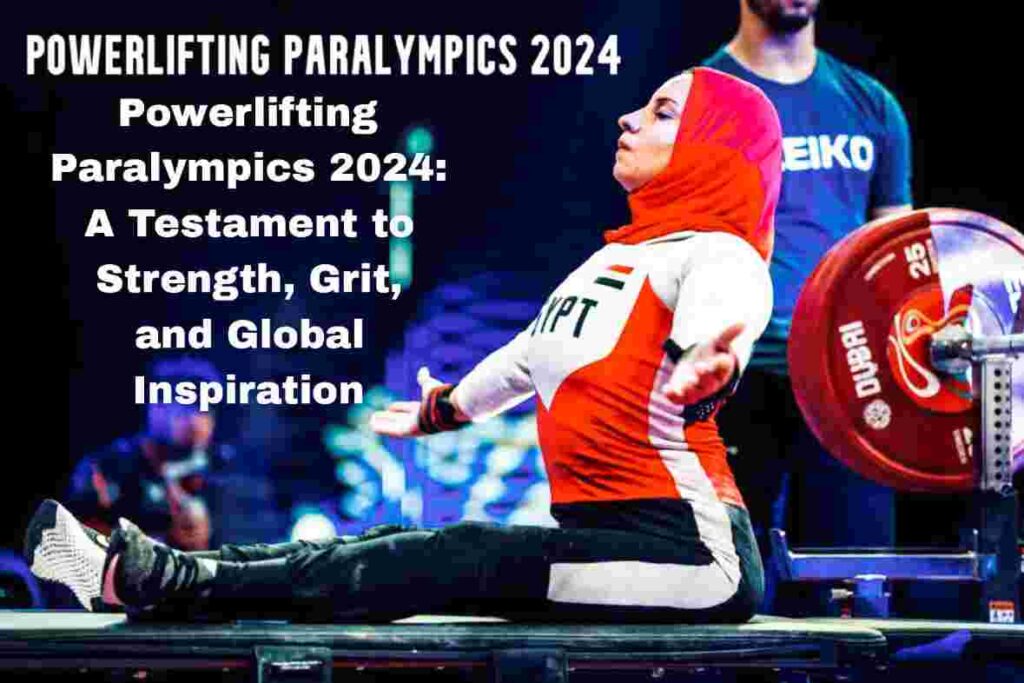When Strength Meets Spirit: What the 2024 Paralympics Tell Us About True Powerlifting Excellence
The 2024 Paralympic Games in Paris were more than just a celebration of athletic prowess—they were a seismic shift in how the world perceives strength, resilience, and the limitless capacity of the human spirit. At the heart of this transformative event was powerlifting, a discipline that continues to redefine the boundaries of physical ability and mental tenacity.
In this article, we’ll explore everything you need to know about powerlifting at the Paralympics 2024—from its rules and standout performances to the deeper cultural impact it’s having on sports and society. Whether you’re a die-hard lifting fan, a curious newcomer, or someone simply looking to be inspired, this guide delivers a rich, expert-backed look at one of the most electrifying showcases of adaptive strength the world has ever seen.
The Evolution of Paralympic Powerlifting: A Brief Overview
From Modest Beginnings to Global Stage
Paralympic powerlifting began in 1964 with a modest lineup of athletes and limited recognition. At that time, the event was exclusively for men with spinal cord injuries. Fast forward to 2024, and the sport now welcomes both men and women from a broad range of physical impairments, and it features in over 120 countries. The evolution has been astounding—not just in technicality but in visibility and respect.
The Rules and the Bench Press Standard
Unlike Olympic weightlifting, which features the snatch and the clean and jerk, Paralympic powerlifting focuses solely on the bench press. Athletes must lower the bar to their chest, hold it motionless, then press it upward to full arm extension. Judges look for control, symmetry, and adherence to strict form—any deviation leads to a no-lift.
Inclusion, Classification, and Competition
To ensure fair play, all athletes must have impairments that meet eligibility criteria under World Para Powerlifting guidelines. This includes loss of muscle power, limb deficiency, or leg length difference, among others. Interestingly, the sport does not have multiple classifications within the event—all athletes compete by weight category, regardless of disability type, making it one of the most competitive sports in the Games.
Powerlifting Paralympics 2024 Highlights: The Defining Moments
Paris as a Powerlifting Powerhouse
The 2024 Games in Paris marked a turning point in the visibility and prestige of Paralympic powerlifting. Held at the Paris Expo Porte de Versailles, the arena was packed, electrified, and brimming with international pride. The live streaming numbers broke previous records, and social media buzzed with clips of gravity-defying lifts.
Standout Athletes Who Redefined Limits
Several lifters etched their names into history during the 2024 event:
-
Siamand Rahman’s legacy loomed large, even though the Iranian legend passed away in 2020. His world record (310 kg) remains untouched, but his influence inspired a new generation of athletes.
-
Amalia Pérez of Mexico, a five-time Paralympic medalist, returned at age 51 to claim silver in the women’s up to 61kg—an extraordinary feat of longevity and precision.
-
Bonface Okombo from Kenya stunned the crowd with a jaw-dropping lift of 221 kg in the men’s 72kg class, breaking an African record and finishing with bronze. It was a major step forward for African representation in the sport.
Controversies, Comebacks, and Courage
There was also no shortage of drama. A controversial no-lift call on China’s Jianping Huang stirred conversation about judging consistency. Meanwhile, Egypt’s Mahmoud Attia made an emotional return after a near career-ending injury in 2022, clinching gold in the men’s 97kg class.
Why Powerlifting at the 2024 Paralympics Mattered More Than Ever
Visibility and Media Attention
For the first time, Paralympic powerlifting was given prime-time television coverage in multiple countries, including the U.S., U.K., and Brazil. Commentators praised the athletes not as “inspirations,” but as elite competitors—shifting the narrative from sympathy to serious athleticism.
Gender Equality in Full Force
The 2024 Games continued to spotlight women in the sport, with equal medal events for men and women and an increasing number of female lifters from underrepresented nations. For instance, Indonesia’s Ni Nengah Widiasih captured bronze, bringing her total Paralympic medal count to three and raising awareness for adaptive sports in Southeast Asia.
The Training Behind the Triumph
Unlike popular perception, Paralympic lifters train with the same intensity and rigor as their able-bodied counterparts. Most of them follow a six-day training split, with tailored regimens that include not just bench press volume but accessory work, mental conditioning, and sports nutrition.
Country Performance Table: Powerlifting Medal Tally – Paralympics 2024
| Country | Gold | Silver | Bronze | Total |
|---|---|---|---|---|
| Nigeria | 4 | 2 | 1 | 7 |
| China | 3 | 3 | 2 | 8 |
| Iran | 2 | 2 | 2 | 6 |
| Egypt | 2 | 1 | 3 | 6 |
| Mexico | 1 | 2 | 1 | 4 |
Nigeria, once again, cemented its dominance in Paralympic powerlifting, thanks to grassroots programs and government-backed training initiatives specifically aimed at para-athletes.
Training for the Podium: What It Takes to Become a Paralympic Powerlifter
Coaching & Technique
Elite Paralympic lifters often work with coaches specialized in adaptive strength programming. These coaches adjust bench height, grip width, and bar path based on the lifter’s unique biomechanics, ensuring maximal force output while staying within legal range of motion.
Equipment and Customization
From specially designed bench straps for stabilization to modified lifting suits, adaptive gear is a huge part of training and performance. Some athletes also rely on cutting-edge technology like neuromuscular stimulation or EMG sensors to monitor muscle activation.
Nutrition and Recovery
Powerlifters at this level follow precision-based nutrition plans—often high in protein and calibrated around competition weight classes. Recovery techniques include cryotherapy, massage therapy, and in some cases, hyperbaric oxygen therapy for faster tissue healing.
Beyond Medals: The Cultural and Social Impact of Paralympic Powerlifting
Representation for the Disabled Community
Each lift on the platform sends a message: disability does not equate to inability. In many countries, Paralympic powerlifters are now seen as national heroes—transforming public perceptions and advocating for inclusivity.
Role Models and Mentorship
Many medalists now serve as mentors through global initiatives like Raise the Bar, a program that connects aspiring lifters in low-income countries with seasoned professionals. These efforts are essential in making the sport more accessible and equitable.
Legacy Projects Post-Paris 2024
Several legacy projects were launched following the Games, including the PowerAbility Paris Initiative, which aims to install adaptive training centers in underserved areas across Europe and Africa. The goal: to turn post-Games momentum into long-term development.
Final Thoughts: Strength Has Many Faces
The powerlifting Paralympics 2024 weren’t just about weights and numbers. They were about stories—of comebacks, courage, and quiet determination. Whether you’re watching from the stands, following the scores online, or pushing your own limits in the gym, the impact of this sport runs deep.
In a world that often defines strength by outward appearance, these athletes remind us that true strength is built from the inside out—through persistence, purpose, and pride.
Frequently Asked Questions (FAQs)
1. What are the weight classes for Paralympic powerlifting in 2024?
There are ten weight classes for men and ten for women, ranging from under 49kg to over 107kg for men, and under 41kg to over 86kg for women.
2. How is Paralympic powerlifting different from Olympic weightlifting?
Olympic lifting includes two lifts—snatch and clean & jerk—while Paralympic powerlifting features only the bench press. It also includes athletes with physical impairments, competing by weight class alone.
3. Who won the most medals in powerlifting at the 2024 Paralympics?
Nigeria led the powerlifting medal tally with four golds, followed closely by China and Iran. Their success stems from structured national programs and world-class coaching systems.
4. Can able-bodied athletes compete in Paralympic powerlifting?
No. Only athletes with physical impairments that meet the eligibility standards set by World Para Powerlifting are allowed to compete.
5. How do Paralympic powerlifters train differently than able-bodied athletes?
While the fundamentals are similar, Paralympic athletes often adapt equipment and technique to accommodate mobility limitations. Recovery, mental training, and biomechanics are also heavily emphasized.
6. Where can I watch highlights or replays of the powerlifting events from Paris 2024?
You can find official replays on the Paralympic Games YouTube channel, the IPC website, and various national broadcasters like Channel 4 (UK), NBC (US), or CBC (Canada).


